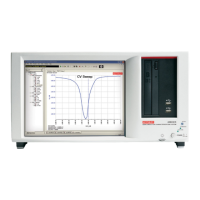3-66 Return to Section Topics 4200-900-01 Rev. K / February 2017
Section 3: Common Device Characterization Tests Model 4200-SCS User’s Manual
vdsid_pulseiv_demo
(Also see vdsid_pulseiv on page 3-51)
vgsid_pulseiv_demo
(Also see vgsid_pulseiv on page 3-57)
scopeshot_pulseiv_demo
(Also see scopeshot_pulseiv on page 3-64)
These three UTMs are functionally identical but simpler than their respective
routines listed earlier in this section of the manual. The difference being less-used
parameters have been eliminated from the parameter list and hard-coded (for
example, SMU channels, ranges, load line).
How to perform a Quiescent-point Pulsed I-V test (PIV-Q) on my
device
Q-Point Pulse IV – Model 4200-PIV-Q
This application provides q-point pulse IV testing for higher power compound
semiconductor or LDMOS RF transistors, or any device may benefit from low duty
cycle pulse IV testing. This application uses the 4200-PIV-Q package, which
differs from the 4200-PIV-A package by:
1) Pulsing both the gate and drain
2) Providing higher power to the DUT drain
3) Pulsing from non-zero bias point, or quiescent point, testing
The compound semiconductor transistors consist of materials made from the III-V
groups in the periodic table of the elements, but other groups or elements may be
Table 3-24
Return values for scopeshot_pulseiv
Value Description
0
OK
-1 Invalid Pulse Width (minimum 40 ns)
-2 Invalid Pulse Period (minimum 40 ns)
-3 Invalid Average Num (1 to 1000)
-4 Array Sizes Do Not Match
-5 Invalid VPU. Specified VPU Is Not In Current System Configuration.
-6 Invalid GateSMU. Specified SMU Is Not In Current System
Configuration.
-7 Invalid DrainSMU. Specified SMU Is Not In Current System
Configuration.
Negative numbers are errors — refer to LPT and PulseIV documentation for description.

